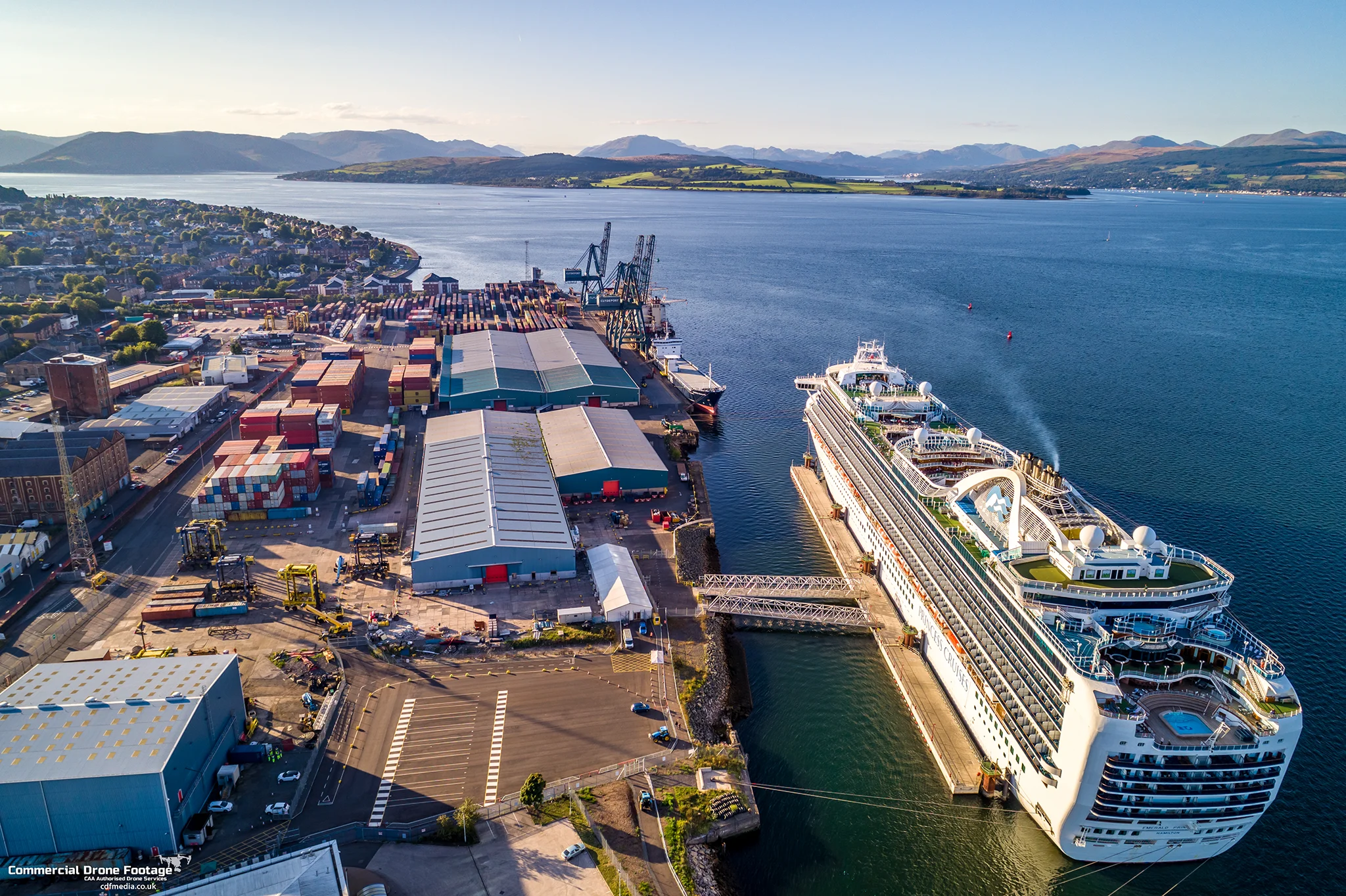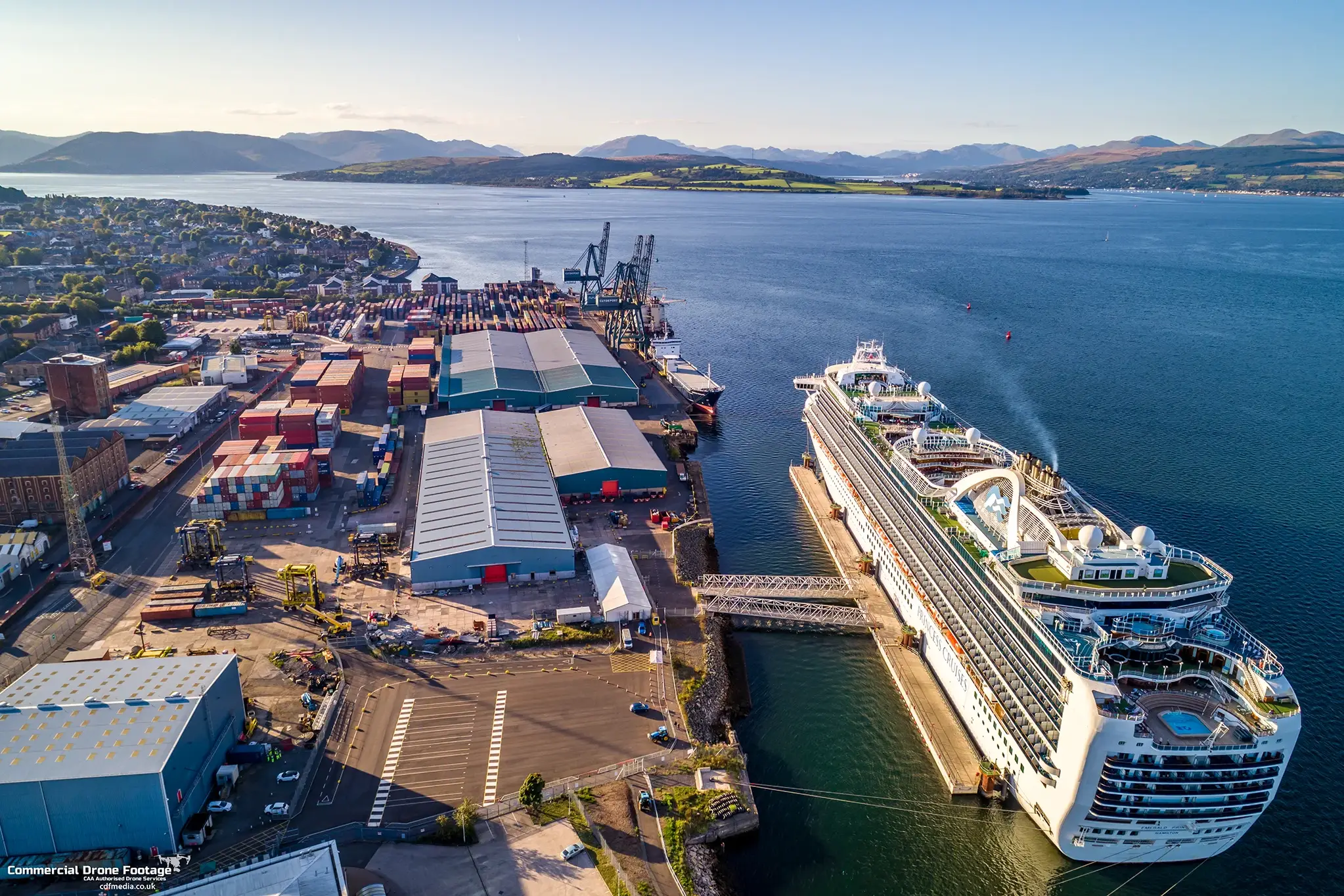01 / Case Study
Peel Ports Greenock Ocean Terminal
DSSR was responsible for the Mechanical and Electrical designs for new cruise liner berthing facilities in the Greenock Port.
Location / Greenock, Scotland
Client / RoadBridge / Arch Henderson
Completion / 2020
02 / Overview
Overview of the Peel Ports Greenock Ocean Terminal project
The Greenock Ocean Terminal is primarily used as a container terminal, however in recent years it has become a popular destination for cruise ships. Bringing cruise ships to the container berth was impinging on Clydeport commercial operations, therefore the decision was made to construct a dedicated cruise ship berth to improve the harbour operation during the cruise season (from May to October).
The project was centred around the design of a 5m-wide, heavy-duty floating pontoon, able to accommodate pedestrian access, passenger baggage transfer, small goods supply—up to large loads such as a 3.5T forklift.
What we provided
Our designs needed to account for challenges specific to marine environments, such as the movement of cables on the moving pontoon and the corrosion risk posed by the coastal environment.
DSSR provided mechanical services design for the installation of a new fire mains/hydrant system, capable of delivering a flow rate of at least 2,100 litres per minute. The main dry fire main pipework was installed along the vehicle/crew access ramp, was fixed to the side and underside of the ramp and pontoon, and was provided with a 2-way dry-inlet valve within a cabinet mounted at ground level (shoreside).
Due to the unique environment, all pipes, fittings, cabinets and valves needed to be highly corrosion resistant, suitable for a coastal environment that is subject to salt water and salt air corrosion.
Flexible dry fire main pipework was also specified to accommodate the hinged gangway i.e. between the fixed platform & gangway, and between the gangway & pontoon. This was specified to account for the natural movement caused by the water so that the installation does not become kinked, overbent, abraided, or trapped between the gangway and pontoon.
In terms of the electrical installation, DSSR was responsible for the design of the services for the lighting for the jetty pontoon, including navigation lights (designed in compliance with all relevant CIBSE codes of practice, BS 5489, and the Guide to Limiting Obtrusive lighting), the LV distribution, and the design of the IP67 steel distribution feeder pillar.
Designs
The pontoon is accessible via two separate access bridges: a 2m wide access bridge for pedestrian access, and a 4m wide access bridge which can accommodate a 3.5 tonne load.
Our electrical designs also needed to account for challenges specific to marine environments, such as the movement of cables on the moving pontoon and the corrosion posed by the sea.
A specialised energy chain cable management system was specified for the pontoon. As the pontoon is a moving object, we needed to specify a moving chain, allowing the cable to expand and contract in response to changing water movements.
All fittings we specified were carefully selected for the unique port environment. This included the correct IP ratings, ensuring the cables were waterproof and appropriate for the salinity of the ocean. All luminaires were specified to be a minimum of IP65, corrosion and aqua-proof. All bollards/columns were specified to be of stainless steel type, anticorrosive, minimum IP65 and based plate mounted.
All the bollards and canopy-mounted external luminaires are wired in BS 6724 compliant multicore XLPE/SWA/LSF cables within buried ducts / galvanized steel conduit/containments, fed from new local distribution feeder pillar.
Lighting Designs
It was important that the lighting designs were made to meet CIBSE & ILP Guidance for the Reduction of Obtrusive Lighting in order to avoid lighting pollution within the port environment.
The pontoons, bespoke for this project, were specified to have minimum 2.0m freeboard, are designed by GDG and their Naval Architects specialist subconsultants for a range of different wave environments including 1:1, 1:50 and 1:100-year events.
In terms of the mechanical installation, DSSR was responsible for the services design for the water fill facility required by the Peel Ports. This required design of the water pipework along the vehicular access bridge including the shoreside inlet and pontoon side outlet. Both the inlet and outlet valve were provided with an above ground GRP enclosure and incorporated a drain down facility for when the system was not in use.
Our designs needed to account for challenges specific to marine environments, such as the movement of cables on the moving pontoon and the corrosion posed by the coastal environment. As the pontoon is a moving object, we needed to specify a moving chain, allowing the cable to expand and contract in response to changing water movements.
Further Considerations
A specialised stainless steel flexible hose was specified for the fixed connections on the vehicular bridge between both the pontoon and shoreside to accommodate for the tidal movements associated with the pontoon and vehicular access bridge. The pipeline material, associated fittings and supports were all specified to Grade 316 stainless steel to meet the requirements of a unique port environment.
The pontoons were constructed using reinforced concrete with infill high-density polystyrene blocks used to aid flotation. The pontoons are connected to the shore by two 46m long bridges: one dedicated to passengers and another for vehicular deliveries and passengers.
Five 2,250mm diameter offshore monopiles, each of which was fitted with parallel motion fenders and mooring bollards, help create the main berthing face, and in addition, further landside bollard locations provide additional mooring points.






